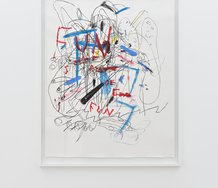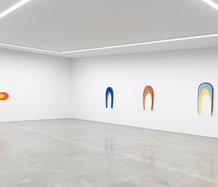John Hurrell – 6 July, 2016
Of the interiors, the images of ruined buildings where the outdoor elements are encroaching are intriguing because time (an aspect prevalent in all Corson-Scott's images) seems a clear component here. This is obvious in a couple of Gisborne Sheep Shearers Woolstore and former New Zealand Shipping Company Building photos, but more subtly apparent in the Frank Sargeson House one where water stains on the roof and walls are detectable.
With this, Corson-Scott’s second show at Trish Clark’s, we see nine large analogue images made this (and last) year, presented as prints pinned to the wall or (as indicated by a couple) framed and under glass. Each image has been allocated an appropriate (optimum) size by the artist: so there are no cross-overs; no double ups. Either 150 x 189 cm, 140 x 175 cm, or 110 x 137 cm. It’s definite.
Five are of coastal scenes of beaches and cliffscapes, two are of the interiors of baches or workshops, and the others are of dilapidated buildings where roofs have collapsed, creating zones that combine aspects of the other two extremes. In all of the images there is some historical or cultural narrative or reference point, but in many of them, especially the land/seascapes, the glowing light in the documented coloured sky, sea or clay cliff-face, is extraordinary. This of course is referenced by the show’s title: a line from Emily Dickinson.
The sun’s presence (seemingly, a constantly reoccurring symbol for present-time, the experience of ‘now’) in these images is all pervading, as is the presentation of fine detail that can bounce off the information in the titles to fascinate the viewer. In Wildflowers in a Development near Tauranga (2015), it is the daisy chain we see in the central figure’s hair, and in Undersea Cables, Pink Beach, Whangapaoa (2015) the squiggles of coloured wire poking out of the sand in front of the exposed, descending, long diagonal, cable box.
The scale of these images makes them a little like abstract paintings, especially the outdoor shots where there are broad expanses of uniformly coloured sky or crumbling earth. Of the interiors, the images of ruined buildings where the outdoor elements are encroaching are intriguing because time (an aspect prevalent in all Corson-Scott’s images) seems a clear component here. This is obvious in a couple of Gisborne Sheep Shearers Woolstore and former New Zealand Shipping Company Building photos, but more subtly apparent in the Frank Sargeson House one where water stains on the roof and walls are detectable - or (outside) where the artist records his colleague Mark Adams pondering the fallen remains of the eroded Maori gardens at Awhitu Peninsula.
Whilst attempting to be cognisant of the past, these images also celebrate the present; overwhelmingly so, through their sensuality. A keen sense of the unique instance of each exposure (its temporal context) dominates.
John Hurrell
 Advertising in this column
Advertising in this column Two Rooms presents a program of residencies and projects
Two Rooms presents a program of residencies and projects



This Discussion has 0 comments.
Comment
Participate
Register to Participate.
Sign in
Sign in to an existing account.